Get Tech Tips
Subscribe to free tech tips.
Zonal Pressure Diagnostics—The Backtalk Series (Part 3)
This article was submitted by Genry Garcia of Comfort Dynamics, Inc. It is the final part of his series on zonal pressure diagnostics. Thanks, Genry!
Updated 3/4/2022
Picking up where we left off in part 2 of the series, we discussed how a pressure reading from an attached zone indicates only the ratio of the collective size of the leaks between the zone and the envelope with relation to the collective size of the leaks between the zone and outdoors (and vice versa). In other words, a ZPD reading by itself does not tell us if a zone is very leaky or not. And it sure doesn’t mean that a given zone is “X% connected to outside.”
Here is a quick visual. First, we see a high ZPD reading (21.3 Pa) taken with a pressure pan over a recessed light. Despite this high-pressure reading, “42% connected to outside,” we see that, as measured with an Acin FlowFinder powered flow hood, it is only contributing less than 5 CFM50 to the total blower door number of the envelope.
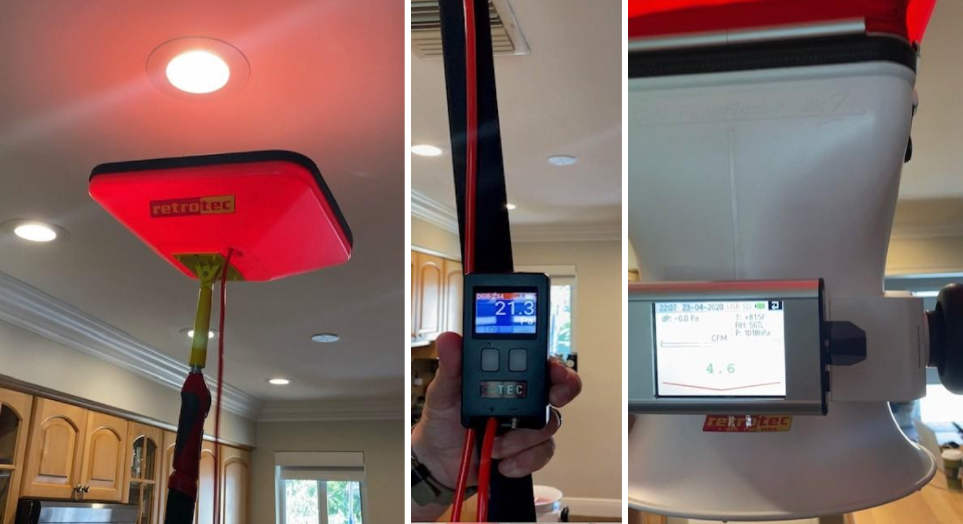
The same day, at the very same house, using the very same instruments, we now see a ZPD reading taking over a supply register of a mere 1.4 Pa. One would be erroneously led to believe that this is insignificant. After all, it is only “2.8% connected to outside,” right? We see, however, that this 1.4 Pa is actually responsible for over 40 CFM50 of the total blower door number for the house. The blower door was running, maintaining the house at -50 Pa WRT outdoors for these tests.
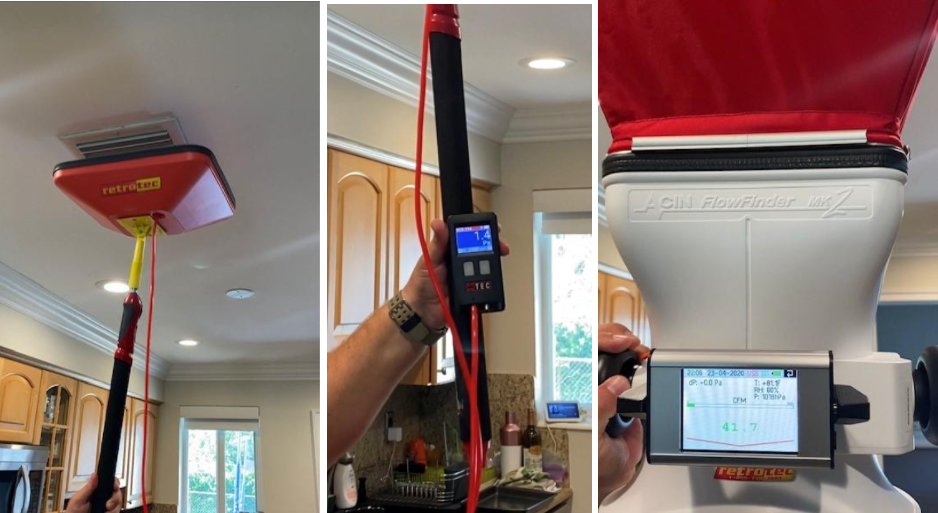
That is 9 times more air leakage for a pressure reading that is 15 times lower.
The margin of error for this method of ZPD interpretation is just too high to be taken seriously.
To understand ZPD readings, we need a second piece of information in addition to the pressure. There are two ways to get to this second factor.
1 – The Add a Hole/Flow Methods
These methods are the gold standard; they are also the most complex. They consist of running the blower door to maintain a (-)50 Pa pressure in the house WRT outdoors and take a ZPD reading of a zone before and after adding an opening of a known dimension between it and the envelope. In cases like a crawl space where there might not be an opening to add between it and the house, the ventilation of the zone to outdoors can also be altered (increased or reduced) to accomplish the same purpose.
Translation: You take a ZPD reading of, say, an attic with the access door closed, as it would normally be. Then, you take another one after intentionally opening it to the house. Once you literally ‘add a hole’ between the house and the attached zone, you create a before and after envelope pressure<>CFM50<>zone pressure relationship that can be converted into how many CFM50 each zone independently contributes to the total CFM50 value for the envelope. We do this using software or charts that have been developed for this purpose.
The two that I have used with repeatable results after enough practice are the ZPD Trainer from The Energy Conservatory (top screenshot) and the zone pressure diagnostics from redcalc.com (bottom). The latter uses what is called the “Add a Flow Method.” To use the Add a Hole method, you’d have to know the dimensions of this added opening between the zone and the envelope.

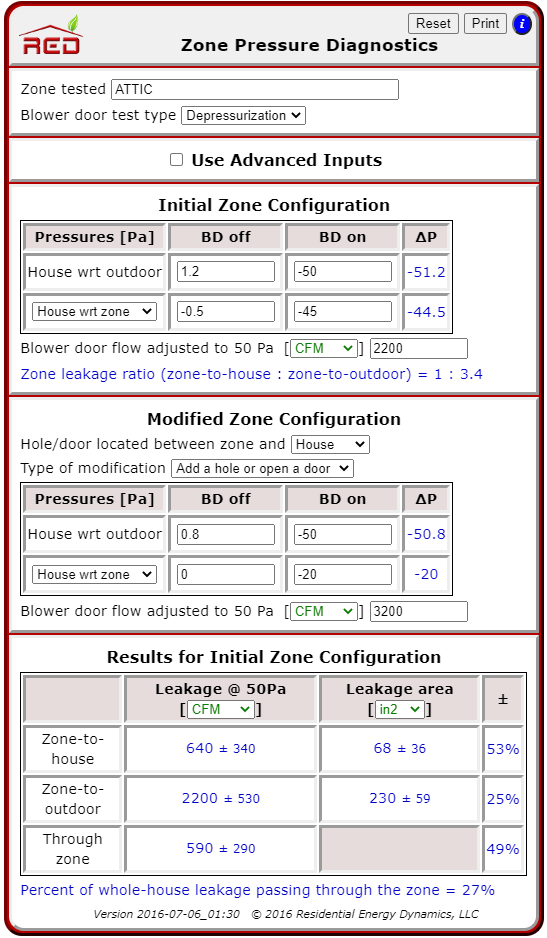
Each of those has an accompanying user’s manual that breaks it down into steps for the user. The ZPD Trainer’s manual is particularly good and detailed. There are, however, several real-life situations that are not mentioned on those.
At the end of this article, you’ll find direct job notes made by yours truly after some trial and error and peppering the experts with questions. They would only make sense once you’ve gone over the user’s manuals for the software linked above, though. So, right after you RTFM, you can come back here for those if you want to dig deeper.
But even without going that deep, one can tell that it looks like a pain in the butt, doesn’t it? That’s because it is… kinda. I suspect that until a more conventional software is developed, this method will remain on the back burner. Imagine a blower door manufacturer that automates the ZPD process as an integral part of their reporting software… A fella can dream.
I can tell you, however, that it wasn’t until I started getting repeatable results using the Add a Hole/Flow methods that it all clicked for me.
2 – G-ZPD (Thanks for the name idea, Bill Spohn.)
Let’s get controversial, shall we? This method is the one I like the most.
I developed this approach after I started running into the same numbers under similar sets of circumstances. Once you identify a breadcrumb trail, you can always follow it home. Broken down in steps:
1. Get an understanding of how well vented are the zones you are testing. Remember this from Part 2?
As a side note, however, attic or crawl space ventilation is pretty straightforward:
- Are there vents along the roof overhang (soffits)?
- Are there vents along the side of the house?
- Can you see light if you go into any of them?
- Can you feel air movement across these vents? – This last one is largely dependent on indoor vs. outdoor temperature differential, as Stack Effect is its driving force. Wind matters a great deal, too.
You don’t necessarily have to calculate the total free area of the ventilation openings for an attached zone. You just need to gain an understanding of if its ventilation pattern.
2. Establish the pressure ratio relationship between the zones and the envelope.

This is where you can estimate how much of a contributor a given zone is to the total envelope leakage (CFM50). By the way, avoid doing ZPD using ACH50. Calculating the volume of an envelope/zone can be a very inefficient experience. Maybe avoid ACH50 altogether… unless, of course, you use 3D modeling software or something similar, or you’re the reincarnation of Pythagoras of Samos. In either case, ACH away, my brethren.
But I digress.
Once you identify an attached zone as well-vented (or not), clock its ZPD reading, and understand the ratio relationship of leaks of the zone to outside vs. the zone to inside, you’ll be way ahead of the curve. It is also an invaluable tool for diagnosing comfort issues within problematic envelopes.
Here is an example:
If you are testing a house with a vented attic, and when you look over to the eave, you see this:
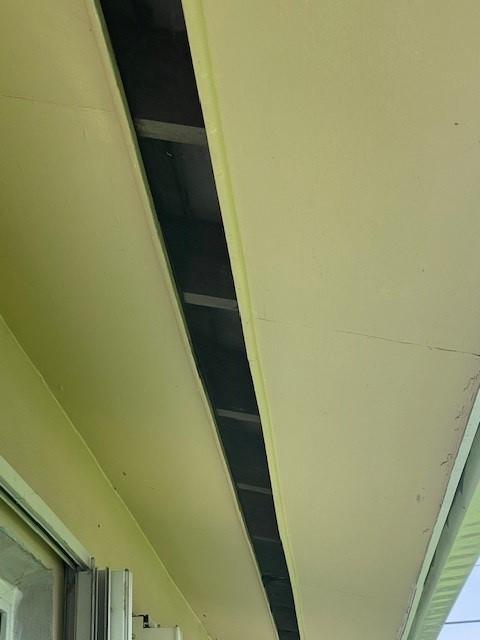
Next, you should confirm that those offer a clear ventilation path from outside and into the attic. If so, then that ZPD reading better be 50 Pa! Otherwise, if it were 48 Pa, for example, then that means that the collective size of all the infiltration paths between this attic and the house is 1/8 the size of the ventilation paths between the attic and outside.
PLEASE look at the photo of that continuous soffit ventilation again and re-read the last paragraph.
Here’s another way of looking at it:
Let’s say you are testing a 3000-square-foot house with a vented attic. It was built to some code, somewhere, requiring 1 square foot of attic ventilation for every 300 square feet of attic floor area. To simplify the explanation, let’s say this is a slab-on-grade house, and the windows/door assemblies, as well as the ductwork, are fairly tight. So, the main concern as far as an envelope leakage contributor is the attic, an attached intermediate zone.
That would mean that this vented attic has 10 square feet worth of ventilation area (3000/300). If a blower door test were done in the house and the ZPD reading of the attic was 49 Pa, then this would mean that the infiltration area from the attic into the house is 1/13th of those 10 square feet (.76 ft2). Since each 1 square foot of leakage contributes about 1400 CFM50, it would, in turn, mean that this is a fairly tight house—or one with a low Leakage Area to Infiltration Ratio™ or LAIR™ (CFM50 to conditioned floor area ratio).
If, on the other hand, the ZPD reading was 45 Pa, then the infiltration area from the attic into the house is 1/4th of the 10 square feet, so 2.5 square feet. This would surely mean that this is actually a fairly leaky house—one with a high LAIR™.
With the exception of cases where windows/doors assemblies and duct (outside the envelope) leakage are the biggest contributors to the total blower door number, the pattern of low ZPD readings from vented attached zones = leaky envelopes is consistent. This is particularly true of zones that share large surface areas or boundaries with the conditioned space, as is the case with attics and crawlspaces.
Remember from part 1: Big hole = Low pressure; Small hole = High Pressure.
3. Assess ZPD readings for interior rooms… maybe.
Masking off the ducts may help.
I don’t mean all the ducts/vents throughout the house—I mean only the duct(s) for the room you’re doing ZPD on. I also don’t mean ventilation ducts terminated directly outdoors—only those that connect the isolated room to the rest of the house once the room door is closed.
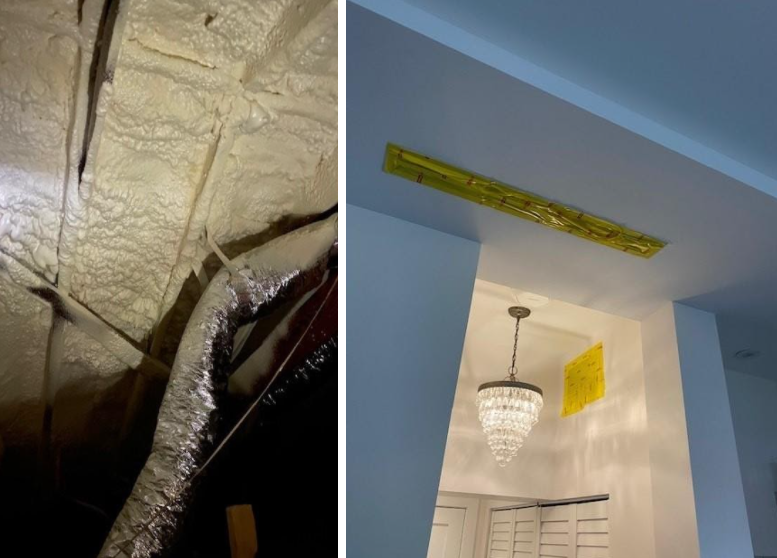
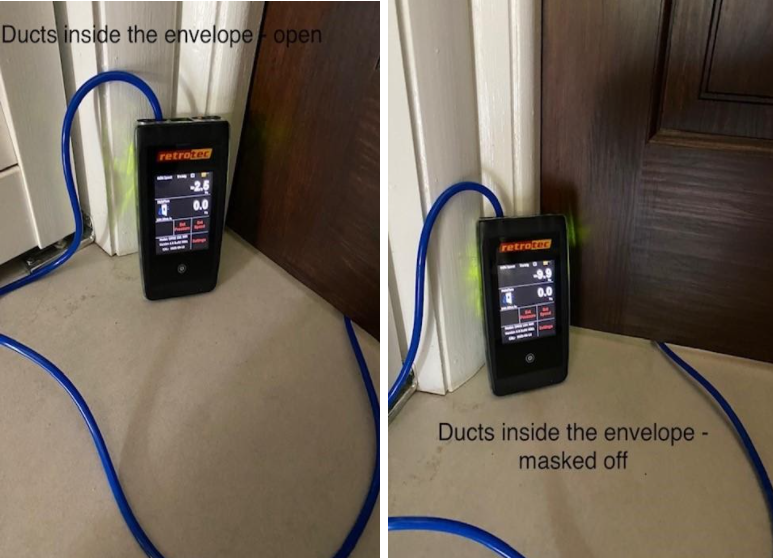
After you’ve covered the vents/ducts from an isolated room, then you proceed to take the ZPD reading from the room, the same way is taught on YouTube.
Once there, you can assess how leaky the room is by slowly beginning to crack the door open to 1-2 inches. If the room ZPD drops to or near zero, then it’s a small leak. If it only drops a little or none, then that means it is a larger leak.
By masking off the ducts, we’ve eliminated the second-largest flow path from a room: out to the rest of the house. That flow path is second only to the door when it is open. But how accurate is this reading, even by eliminating the ducts as a flow path?
The ZPD of interior rooms is highly inaccurate by nature. Once you close the door to a bedroom, even if the ducts that connect that room to the rest of the house are covered, there are still a million ways in which air can travel out of the “isolated” room. Air being driven by any mechanical or natural pressure differential will follow the path of least resistance.
For instance, if the blower door is running and a bedroom door is open, then:
The air leakage from outside being forced through the bedroom will travel out the doorway if the door is open. Close the door, and it will travel out through the ducts – mask off the ducts, and it will travel out through electrical conduits, fixtures, or weak caulk lines on baseboards/moldings. Partition walls have an infinite amount of interstitial spaces’ connections between them.
So, is internal rooms “ZPD” wrong? Should folks stop doing it?
Not necessarily—not as long as is not misrepresented. If ZPD aids in presenting the case to the client and therefore improves the chances of selling a job that will ultimately benefit the end consumer from energy efficiency and comfort perspectives, then how wrong is it really? It is, however, very inaccurate. Getting a pressure reading other than zero from a room isolated by a door during a blower door test indicates that there is leakage from outside. But it doesn’t tell you how much.
At this point, setting ZPD aside and breaking out the thermal imager or the smoke tracer would probably work best—that is, if finding these leaks is important to the client given the particular purpose of the testing.
The Pulse of the Industry
So, since ZPD has been around for decades, I’m cautiously convinced that I can’t possibly be the first one ever to have figured this out. Therefore, there’s got to be a reason why ZPD testing is only used by pros in the field in this form of ZPD Theater where we tell homeowners that their room is “X% connected to outside” like that, by itself, has any meaning.
Using the first two parts as context, some technicians partook in a rather passionate discussion in this Facebook group post.
Smart arguments were made on both sides. From what I gathered, the strongest position against “advanced” ZPD testing is that its complexity will actually confuse clients and be detrimental to the sale of much-needed advanced home performance testing.
Now, this is a legit argument. If ZPD is used as part of a sales strategy, it can absolutely ruin it for you, the tester. And more importantly, it can ruin it for the homeowner, who is really the party that will benefit the most from proper testing, diagnosing, and tailored improvements to their home. It is also true that ZPD testing doesn’t have to be a must-do on every home performance evaluation that involves a blower door test.
But does that mean that it should be neglected?
There is also little chance that homeowners will learn the refrigeration cycle. Therefore, they’ll never completely understand why it is that they need a new metering device, for instance. Should we then, as HVAC pros, unlearn superheat and subcooling and recede into the beer-can-cold days?
I mean, it is not like the average client can read a fan table. So, are we going to give up on static pressure too?
Zonal Pressure Diagnostics is a diagnosis tool—a very valuable one. Use it at your own discretion or not, but if you do, consider improving its practice.
I’ll wrap it up with this perfect quote by Mr. Dale Sherman with permission, from one of his comments on the Facebook discussion:
“…it’s important to have a good technical grasp on the various Building Science factors such as ZPD, but only use them to support the larger mission.
Learning ZPD well takes time, but it will prove incredibly useful as another tool in your belt. Keep in mind that progress will be slow when learning a new process. But once you have a solid grasp of the many, many ways to use ZPD (beyond classroom basics), you’ll be able to pull it out of your tool bag when necessary to quickly diagnose problems onsite… Having a good grasp of the science will serve you well, just don’t parade it out for every home when often all that’s needed is triage treatment.”
I want to give a very special thanks to Dr. Collin Olson from The Energy Conservatory for taking hours and hours of his valuable time to guide me through the testing and better understanding of Zonal Pressure Diagnostics.
Until the next one, here are the promised ZPD Field notes on the Add a Hole/Flow Methods:
Field ZPD Notes
1. With the blower door running, if an exterior zone like an attic or garage is at 50 Pa WRT house, then that suggests little to negligible leakage between said zone and the house. However, the nuance of these spaces suggests that since an attic or crawlspace, for example, will have more area of a shared surface–the ceiling, in the case of the attic, and the floor, in the case of the crawl. Then, further consideration to investigating leakage through these is warranted.
A garage may have one or two walls with very little through penetrations, connecting it to the rest of the house. However, if, for instance, that garage were under an attic, and there were a series of paths above the ceiling line connecting the attic for the garage to the one for the house, intended or otherwise, then there would be mixing of the garage and attic’s leakage. In this case, if the garage and attic’s leakage were to be quantified, then they may add up to a number larger than that of the total leakage for the home.
2. To quantify the leakage contributed by a zone more accurately, the pressure differential between it and the house should preferably be between 10 to 40 Pa with the blower door running. Not 50 Pa, not 0 Pa. If a zone is at 50 Pa or “completely outside,” then the venting for the said zone can be covered for the purpose of the test until brought down to 40 Pa or below.
In the case of a garage, this test is performed with the garage door(s) on the external pressure boundary closed.
3. To quantify this leakage from external zones into the envelope, we can use the Add a Flow method, which is a little different than the original “Add a Hole” method, wherein the hole size that was added needed to be measured. This means that we have to record the CFM50 number as well as the pressure of the house WRT to the zone while isolated—and then again after purposely adding an opening in between the zone and the house, like opening a garage door to the house or attic hatch.
This opening should be as large as possible without surpassing the flow capacity of the blower door fan. The object of “adding this hole” is to have as low as possible a pressure differential between the house and the zone with a minimum zone drop of 10 Pa from its initial pressure. The lower the pressure differential, the lower the margin of error will be. To avoid velocity pressure affecting the modified zone configuration (open door/hatch to the house) – pressure reading, the open end of the sampling tube in the zone can be moved about 10 feet away from the opening.
4. If two vented zones (e.g., an attic and crawlspace) have the same ZPD reading, it doesn’t necessarily mean that they are both equal contributors to the total CFM50 blower door number for the envelope. Even if they have the same surface area as the boundary between them and the house (ceiling and floor), the ventilation area for these zones will likely be different. Therefore, a second factor –Add a Hole/Flow—would have to be used to interpret the ZPD reading of each properly.
—Genry Garcia
Comfort Dynamics, Inc.











Comments
Excellent material, Genry! Thanks for sharing!
Excellent material, Genry! Thanks for sharing!
To leave a comment, you need to log in.
Log In